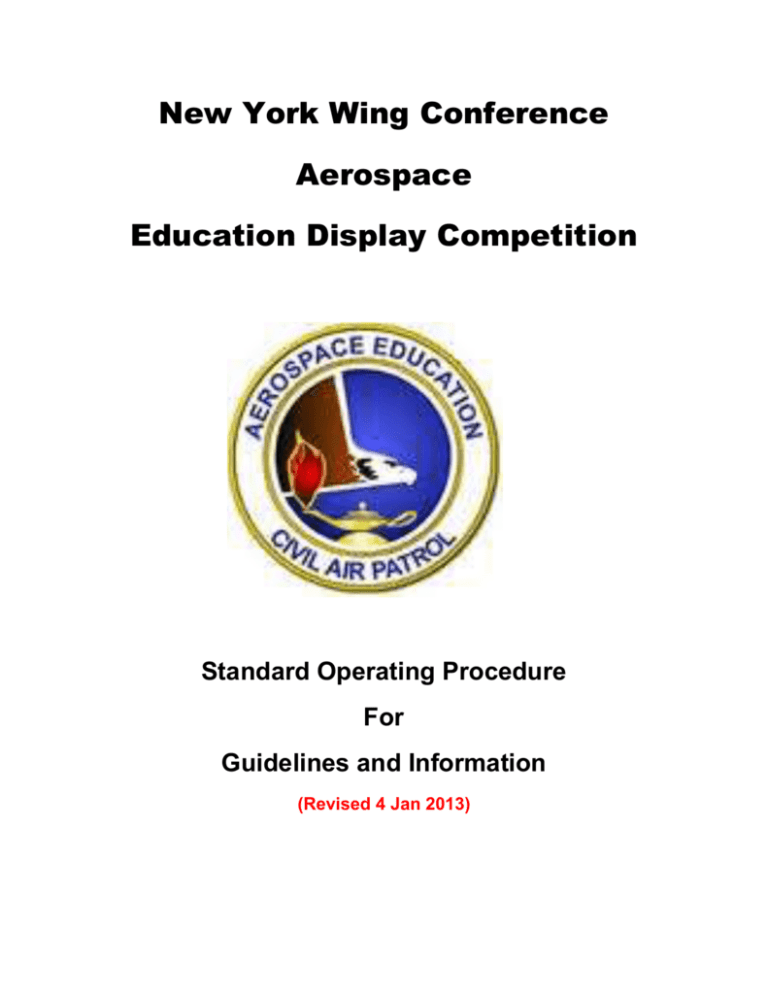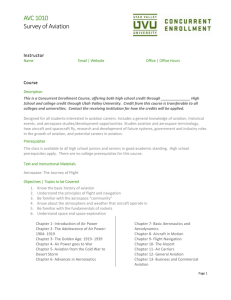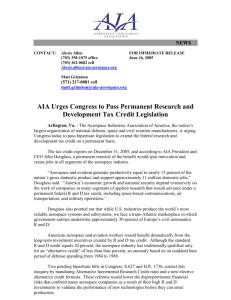civil air patrol
advertisement

New York Wing Conference Aerospace Education Display Competition Standard Operating Procedure For Guidelines and Information (Revised 4 Jan 2013) SUMMARY The New York Wing (NYW) Conference Aerospace Education Display Contest is an opportunity for Civil Air Patrol (CAP) members to share their knowledge of aerospace with others. Participants present an aerospace topic that they may have a special interest exploring. Topics may include history, notable people, aircraft, space craft, flight procedures, systems, CAP areas of interest, air carriers, general aviation, airports, weather, propulsion, aerodynamics, events aerospace companies, careers, future trends, etc. After conducting research on the topic area of choice, teams prepare a tri-fold background that summarizes the topic. Models, demonstrations, displays, tools, examples or artifacts can be displayed in front of the tri-board. Teams/presenters then give a brief 10 to 15 minute talk about their topic. Since the program event generally lasts about two hours, teams may give their presentation several times. Awards are given for the 1st, 2nd and 3rd place winners. Each individual receives a Certificate of Recognition with the Overall 1st Place Winner qualifying for the wing’s traveling trophy. GOAL The Wing Aerospace Education Display Contest (AEFDC) is a key element of the Annual New York Wing Conference. The GOAL is to design a project to give Civil Air Patrol (CAP) cadets and senior members a forum to demonstrate and improve their knowledge of aerospace through topic research, development of a project display and presentation of a selected topic. Cadets who have entered their school’s Social Studies Fair or Science Fair may notice a similarity with the NYW AEFDC. The AEFDC has many of the same elements. The primary difference is that original research (such as conducting surveys, interviews, experiments, etc.) is not required unless it is specifically part of the project. Think more in terms of writing a research paper or project and then defending it by presenting the information to an audience. GUIDELINES Adhere to the following simple rules: (1.) Projects are entered as teams representing each New York Wing. Group and may be entered by teams of up to six members -- cadets and senior members. The names of all team members must be on the entry form (see Attachment A). Presenters WILL be cadets and will be limited to no more than three. 2. (2.) The AEFDC will last approximately two hours with the team given 10 to 15 minutes to make their presentations. If necessary, the team must be prepared to repeat the presentation for the next audience. (3.) Judges will evaluate each team display and presentation. (4,) Adult guidance, mentoring and supervision are required. However, cadets should do the research, construction and demonstration of the display. (5.) Project components should meet all criteria shown on the judge’s score sheet (Attachment B). (6.) Presenters are responsible for setting up the project for display and must remove it at the required time. (7.) Presenters and judges will complete critique form (Attachment C). AWARDS Certificates of Recognition (Attachment C.) will be given for the 1st Place, 2nd Place and Places. The Overall 1st Place winner also qualifies for presentation of the Lt. Col. Ruth Nichols, CAP, Memorial Award, a traveling trophy (Attachment D.). 3rd TIMELINE 1 January – Select Topic. 15 January – Seek unit commander approval. 20 January – Start research. 15 February – Continue research. 1 March – Registration forms due to Wing DAE 15 March – Start constructing displays. 31 March – Continue construction. 15 April – Demonstrate project to unit and group commanders. May – Aerospace Education Display Contest at the Wing Conference Aerospace Education Topic Suggestions The following is a list of potential topics for the aerospace education fair. You may select one of the topics or chose one of your own. Also see The Aerospace Curriculum published by NHQ CAP Aerospace Education Division. You also may choose a topic from any AEX booklet. Flight/Flight Operations Aircraft Systems Airspace Engines Airport DUATS FAA Regulations Aircraft Instruments Emergency Procedures Flight Maneuvers 3. Flight Simulation High Altitude Jet Engines Flight Theory Aerodynamics Night Flying Theory High Altitude Physiology Piston Engines Aircraft/Spacecraft Airbus A340 Beachcraft Bonaza Beachcraft T-34 Beachcraft King Air Bell X-1/X-2 Bell P-59 Boeing 247 Boeing B-10 Boeing B-17/Boeing 307 Boeing B-29 Boeing 707/KC-135 Boeing 727 Boeing 737 Boeing 747 B-1B Lancer DC-3 DC-9 Cessna 150/152 Cessna 172/T-41 Cessna 182 Cessna A/T-37 Gippsland GA-8 Horton Ho 229 Messerschmitt 163 Messerschmitt 262 North American XB-70 North American P-51 F-16 F/P-80/T-33 Lockheed P-38 Explorer Vanguard Mercury Gemini Apollo Dyna-Soar X-15 Space Shuttle Hubble Telescope Voyager X-Aircraft Mars Rover International Space Station Orien Satellites People in Aviation and Space Juan Trippe Howard Hughes Wright Brothers Amelia Earhart Chuck Yeager Glenn Curtis Tuskegee Airmen John Glenn Sally Ride Charles Lindburgh Jimmy Doolittle Neil Armstrong Warner von Braun WASP John Travolta Dick Rutan Chesley Sulenburger Henry H. Arnold Frank Borman Horton Brothers Frank Whittle Aerospace Careers Pilot Air Traffic Control Astronaut Flight Attendant Avionics Repair Teacher Mechanic Aerospace Engineer Aviation Institutions, Agencies and Organizations FAA USAF Army Aviation Naval Aviation Marine Corps Aviation Air & Space Museum Blue Angels Thunderbirds Snowbirds EAA FSS NASA AOPA NTSB Space Camp AMARC (Aerospace Maintenance and Regeneration Center) 4. Aviation Companies Pan Am BOAC Curtiss Aviation Boeing Eastern Airlines Aeroflot Northrop Cessna TWA General Dynamics Consolidated Piper Events Aviation in World War I Aviation in the Korean War Strategic Bombing EAA Airshows Aviation in World War II Alaskan Aviation Flying Tigers Pancake Breakfasts Aviation in Vietnam Berlin Airlift Disaster Relief 5. Attachment A. NYW Aerospace Education Display Entry Form (All information must be typed or neatly printed) Unit/Charter Number: ___________________________________________________ Team Members (Rank/Name(s): (1.) ______________________________________________________ (Identify team leader/presenter/member/ mentor) (2.) ______________________________________________________ (3.) ______________________________________________________ (4.) ______________________________________________________ (5.) ______________________________________________________ (6.)______________________________________________________ Title of Project: _________________________________________________________ Contact information: __________________________________________________________ __________________________________________________________ __________________________________________________________ Telephone/E-mail:_______________________________________________________ 6. Attachment B. NYW Aerospace Education Display Competition Judge’s Score Sheet Name____________________________________________ Unit _____________________________________________ Rank ____________ Title of Exhibit ___________________________________________________________ VISUAL DISPLAY (CIRCLE ONE IN EACH CATEGORY – MAXIMUM 60 POINTS) Display clearly communicates the nature of the subject Display explains what the presenter has learned about the subject Display shows creativity/originality Accuracy, neatness and craftsmanship Has pleasing sensory/visual effect Tables, graphs, and/or illustrations are used effectively Display of references are (minimum of five) Correct grammar Correct spelling Correct punctuation Section Total METHODOLOGY 0 0 0 0 0 0 0 0 0 0 1 1 1 1 1 1 1 1 1 1 2 2 2 2 2 2 2 2 2 2 3 3 3 3 3 3 3 3 3 3 4 5 6 4 5 6 4 5 6 4 5 6 4 5 6 4 5 6 4 5 6 4 5 6 4 5 6 4 5 6 [_____] (CIRCLE ONE IN EACH CATEGORY_-- MAXIMUM 48 POINTS) In-depth investigation of adequate and reliable resources Sufficient information upon which to base conclusions Relevance (all information is based on project topic Evidence of interpretation and analysis of information related to subject Section Total 0 0 0 0 2 2 2 2 4 4 4 4 6 6 6 6 8 8 8 8 10 12 10 12 10 12 10 12 [_____] ORAL PRESENTATION (CIRCLE ONE IN EACH CATEGORY – MAXIMUM 24 POINTS) Knowledge of content Confidence, poise and projection 0 2 4 6 8 10 12 0 2 4 6 8 10 12 Section Total [_____] Grand Total [_____] Comments: 7. Attachment C. NYW Aerospace Education Display Competition Evaluation/Critique Form As a participant or judge, your feedback is very important. This evaluation is divided into four categories to determine the effectiveness of the entire project. Please rate each indicator using the following continuum: 1=Poor; 2=Below Average; 3=Average; 4=Good; 5=Excellent. STANDARD OPERATING PROCEDURE ________(CIRCLE ONE IN EACH CATEGORY) Was the content organized Was the material useful/helpful Was the material appropriate for the audience PRESENTATION 1 1 1 3 3 3 4 4 4 5 5 5 ________(CIRCLE ONE IN EACH CATEGORY) Participant had adequate opportunity to present subject 1 Activities were relevant and engaging 1 Effective use of visual aids 1 PARTICIPANTS/JUDGES 2 2 2 2 2 2 3 3 3 4 4 4 5 5 5 ________(CIRCLE ONE IN EACH CATEGORY) Did learning take place? Anticipated results/goals were achieved Participation was an effective use of my time? Presentations offered new insights and/or knowledge? 1 1 1 1 2 2 2 2 3 3 3 3 4 4 4 4 COMMENTS: What did you enjoy about the competition? Was there anything you did not understand about the competition? What was the most valuable thing that you learned? Other comments? 8. 5 5 5 5 Attachment D. CIVIL AIR PATROL UNITED STATES AIR FORCE AUXILIARY CERTIFICATE OF RECOGNITION Awarded To: FIRST & LAST NAME (1st, 2nd or 3d Place) For excellence in demonstration at the Annual New York Wing Aerospace Education Display Competition. . Given this __________________________ Commander 9. Attachment E The Lt. Col. Ruth Rowland Nichols, CAP, Memorial Award The Lt. Col. Ruth Rowland Nichols, CAP, Memorial Award is a traveling wing trophy that consists of a stainless steel model of the Italian Macchi M.39 that won the 1926 Schneider Cup race at Hampton Roads, Virginia and set a land speed record of 246.9 miles an hour. The symbolism to Colonel Nichols is because she was rated in seaplanes, held numerous aviation records, and broke the sound barrier while flying in a TF-102 Delta Dagger – the first woman to fly this supersonic fighter. THE WINNING GROUP IS ENTRUSTED WITH THE TROPHY FOR ONE YEAR AND THEN RETURNS IT TO WING AT THE NEXT WING CONFERENCE. 10. Lt. Col. Ruth Rowland Nichols, CAP 1901-1960 -- Known for more than 35 women's aviation records Ruth Nichols was born in New York City. Her father, a member of the New York Stock Exchange, had been one of Teddy Roosevelt's Rough Riders, and her mother was a strict Quaker. For her high school graduation, her father presented Ruth Nichols with an opportunity to ride in a plane with Eddie Stinson, ace pilot of World War I. She began secretly studying to fly even as she studied at Wellesley College, planning for a career as a physician. Shortly after her graduation from Wellesley, Ruth Nichols became the first woman in the world to earn an international hydroplane license. In 1927, she was one of the first two women to receive a Department of Commerce transport license. By 1923, she soloed in a seaplane and became the first woman licensed in a flying boat. Joining Harry Rogers for a flight from New York to Miami in 1927 on New Year's Eve led to public recognition for Ruth Nichols. Fairchild Airplane and Engine Company offered her a sales position, and she tried a number of ventures connected with sports flying. With the Depression, Ruth Nichols turned to competitive flying, and in 1930 went to work for Crescent Aircraft where the company would allow her to spend most of her time in competitions. She began to make a name for herself as an aviatrix. In 1931, Ruth Nichols broke three major women's records: altitude, speed and distance. Although she failed in her attempt to cross the Atlantic; injuring her back and even watched her plane go up in flames the day after breaking the women's distance record with her flight from Oakland, California, to Louisville, Kentucky, Nichols worked to raise funds to replace her plane. In 1932 she also was part of the "good will tour" promoting the International Congress of Women in Chicago for 1933. Her dream of being the first woman to fly across the Atlantic was shattered when Amelia Earhart achieved that feat in May, 1932. (Years later, she'd join Earhart in founding the NinetyNines, an organization promoting women pilots.) Ruth Nichols tried a flight from New York to Los Angeles for another record, but her planned recordbreaking flight failed again due to plane failure. She did, however, achieve more notoriety with that flight by using it to drop campaign literature for Herbert Hoover. Continuing to lecture and to raise funds, as well as to fly as often as possible, in 1935 Ruth Nichols was badly injured in a flaming crash during an emergency landing of a transport plane in Troy, New York. After this, Ruth Nichols worked to apply her aviation skills to humanitarian projects. In 1939, she founded Relief Wings, a civilian air ambulance service, and by the fall of 1941 had established centers in most states. This project was absorbed into the Civil Air Patrol when the US entered World War II in December 1941. Ruth Nichols worked as a nurse and flight instructor during the war and piloted a world tour for UNICEF in 1948. Nichols continued to set new records; setting women's speed and altitude records. In 1959, as NASA's Mercury program was preparing for missions to orbit the Earth, she was part of a test group of women -- The Mercury 13 -- who underwent the same isolation, centrifuge, and weightlessness tests that had been devised for the male astronaut candidates. Lt. Col. Ruth Nichols was the only woman to hold the women's world speed, altitude, and distance records simultaneously for heavy landplanes. She was rated in the dirigible, glider, autogiro, landplane, seaplane, amphibian, monoplanes, biplanes, tri-planes, twin and four engine transports and supersonic jets. Nichols was posthumously inducted into the National Aviation Hall of Fame in 1992. A Hamilton variable pitch propeller from her Lockheed Vega is on permanent display at the National Air and Space Museum’s Golden Age of Flight Gallery. 12.






